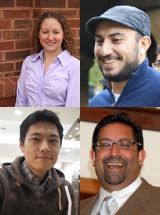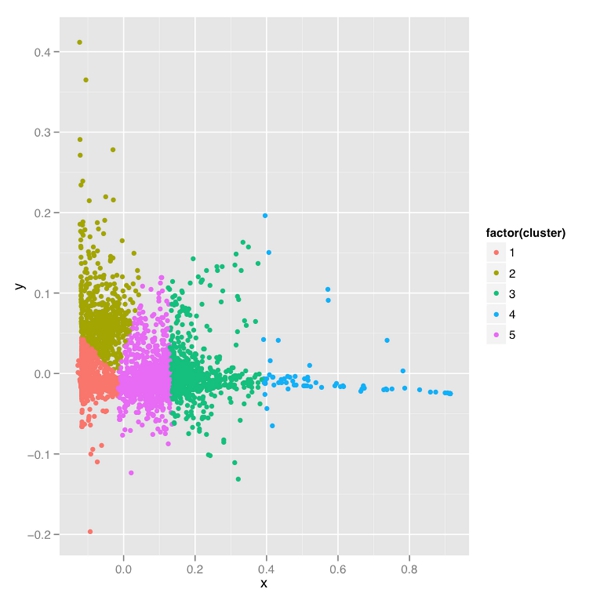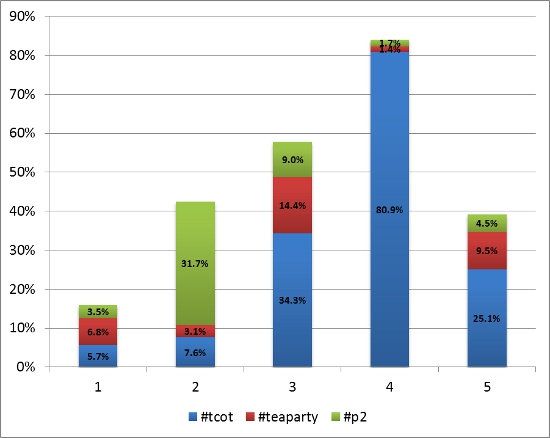 In U.S. politics, the main narrative tends to manifest as left vs right, Democrat vs. Republican, but is this reflected in the social media sphere as well? In new research which maps how hashtags in political tweets were used in the lead up to the 2010 Congressional midterm elections, Leticia Bode, Alex Hanna, JungHwan Yang, and Dhavan V. Shah found that some hashtags occurred in discussion groups that were their ideological opposite. They write that this ‘hashjacking’ was a way in which conservatives were able to enter and disrupt a more liberal community’s online discussion.
In U.S. politics, the main narrative tends to manifest as left vs right, Democrat vs. Republican, but is this reflected in the social media sphere as well? In new research which maps how hashtags in political tweets were used in the lead up to the 2010 Congressional midterm elections, Leticia Bode, Alex Hanna, JungHwan Yang, and Dhavan V. Shah found that some hashtags occurred in discussion groups that were their ideological opposite. They write that this ‘hashjacking’ was a way in which conservatives were able to enter and disrupt a more liberal community’s online discussion.
The dominant narrative about contemporary American politics tells the story of simple left-right polarization. In popular media and elsewhere, politicians and their constituents are either labeled as Democrats or Republicans, Liberals or Conservatives, eschewing any nuance within these political positions. This is thought to be particularly true in the realm of online and social media, where ideological homogeneity creates echo chambers that are thought to reinforce partisan leanings.
Yet this narrative may be incomplete. Citizens may not be sophisticated enough to follow political elites’ talking points or may take much more diverse stances based on their life styles. Social media, more flexible than traditional media, allows citizens to carve out their own arenas of discussion and discursive communities. These communities act as smaller public spheres or issue publics, and may not conform to the simple right-left distinction that is often asserted but rarely tested.
In new research, we focused on disentangling the various online political communities in the U.S. beyond the left-right divide. To do so, we looked at a large dataset from the few months leading up to the 2010 midterm elections in the United States. We catalogued most races for the U.S. Congress, tracked the candidates’ Twitter accounts, and then took a sample from among their followers. We then assembled all of the tweets of those followers, and considered how they used various hashtags in their tweeting.
Hashtags are employed by social media users to tag content according to specific topics. For politics, this can mean classifying content for a specific political campaign (#UKelection), tagging content as relevant to a particular party (#dems) or ideology (#tcot), or referencing particular issue areas (#immigration). This is a unique feature, in that it allows users to identify themselves and to associate with others based on interest in similar topics. Users can search on a hashtag of interest to find relevant tweets, allowing for greater engagement with the Twitter community. In this way, we expected to see how political Twitter in the US formed unique clusters based on shared hashtag usage.
Using two techniques – multidimensional scaling and k-means clustering – we were able to determine how different hashtags co-occur – that is, how tweets used multiple hashtags together. Multidimensional scaling is a method of drawing units with similar features together on a lower dimensional surface. With two dimensions, this reduces into a simple graph in which points can be placed on a horizontal and vertical axis. K-means clustering is a method of grouping similar points together based on how far they are from a hypothetical center. Over a sufficiently large sample of tweets, these methods allow us to see patterns in how users are grouped together by the different combinations of hashtags they used.
We found that the hashtags cluster into five different groups – far more than the two that would be expected from a simple left-right divide. As Figure 1 illustrates, the first cluster has no particular political leaning. Cluster 2 is clearly progressive (shown by the frequency of #p2 or progressives 2.0), whereas clusters 3, 4, and 5 are all different manifestations of conservatism.
Figure 1 – Multidimensional scaling map of the Political Twitter Users

Note: Clusters created Using k-Means
Clusters 3 and 4 look similar ideologically, but cluster 3 distinguishes itself by a unique hashtag use behavior we refer to as Hashjacking. As Figure 2 shows, Cluster 3, while ideologically conservative, makes regular use of left-leaning hashtags, presumably in order to either 1) engage or attack with the other side or 2) steal attention away from the other side. About 20 percent of the tweets in Cluster 3 engaged in this strategic communication behavior, whereas cluster 4 mostly consists of conservative hashtags.
Cluster 5 is focused mainly on Tea Party hashtags and politicians. It is worth remembering the importance of the tea party in the 2010 election, and also worth noting that this was clearly a separate movement from traditional conservatism. Based on its hashtags, the Tea Party movement was engaging in distinct communication patterns from other conservatives.
Figure 2 – Dominance of Three Most Prominent Hashtags across Five Clusters

Note: #p2: Refers to Progressives 2.0, #tcot refers to ‘Top Conservatives on Twitter’
We expected to see that distinct issue communities that transcended the left-right divide formed by expressive behaviors on Twitter. We did see evidence for this by being able to differentiate between more rigid partisan Twitter users and those who were involved with Tea Party activism. In a word, conservatives during the 2010 elections were more fragmented than liberals and conservatives participated in “hashjacking” as a means of impinging on a discursive community which was not technically theirs.
In the run-up to the 2016 presidential election, we expect this landscape to change further. While the prominence of the Tea Party has waned within the past several years, we are seeing different strains of conservatism emerge as Republicans decide on a single presidential candidate. The Tea Party’s libertarianism may manifest in Senator Rand Paul, while a Republican Party concerned with immigration may rely more on Ted Cruz or Marco Rubio. Similarly, while the Democratic consensus supports a run by Hilary Clinton, the left-wing of the party has its eyes on Elizabeth Warren and Bernie Sanders. For all of these communities, we can expect to see expression in distinct online communities which engage, challenge, and disrupt each other. Identifying these communities allows researchers and the public to engage with US politics beyond the simple left-right dichotomy.
This article is based on the paper ‘Candidate Networks, Citizen Clusters, and Political Expression: Strategic Hashtag Use in the 2010 Midterms’, in The ANNALS of the American Academy of Political and Social Science.
Featured image credit: Théo (Flickr, CC-BY-NC-SA-2.0)
Please read our comments policy before commenting.
Note: This article gives the views of the author, and not the position of USApp– American Politics and Policy, nor of the London School of Economics.
Shortened URL for this post: http://bit.ly/1Bl8HW8
_________________________________
 Leticia Bode – Georgetown University
Leticia Bode – Georgetown University
Leticia Bode is an assistant professor of Communication, Culture, & Technology at Georgetown University, with affiliate appointment in the Department of Government. Her research focuses on the intersection of politics, technology, and communication.
 Alexander Hanna – University of Wisconsin–Madison
Alexander Hanna – University of Wisconsin–Madison
Alexander Hanna is a PhD candidate in sociology at the University of Wisconsin–Madison. Alex is interested in social movements, media, and computational social science.
 JungHwan Yang – University of Wisconsin–Madison
JungHwan Yang – University of Wisconsin–Madison
JungHwan Yang is a PhD candidate in the Department of Journalism and Mass Communication at the University of Wisconsin–Madison. His research interests include computational methods and political communication.
 Dhavan V. Shah – University of Wisconsin–Madison
Dhavan V. Shah – University of Wisconsin–Madison
Dhavan V. Shah is Maier-Bascom Professor at the University of Wisconsin–Madison, where he is director of the Mass Communication Research Center. He is housed in the School of Journalism and Mass Communication, with appointments in Industrial and Systems Engineering, Marketing, and Political Science. His work concerns framing effects on social judgments, digital media influence on civic and political engagement, and the impact of health information and communication technologies on chronic disease management.




Social media has completely changed the way we do our politics. In fact the one who wins the Hashtag debates and other social media wars is certainly guaranteed to win a political seat. Currently its unto losers to ignore social media debates at their own peril. Social media is truly a voice of the modern electorate.